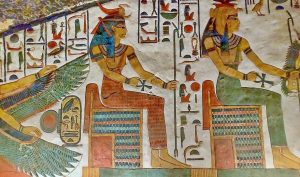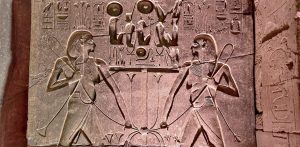Egyptian museums are a treasure trove of culture and science, as well as a cultural and scientific legacy for humanity: Egypt is at the forefront in its antiquities collection, which is housed in tens of unique museums and represents a significant cultural treasure that has made them centers for research and reflection on ancient Egyptian civilization, world civilizations, and current culture. Museums are an important part of the culture. According to the figures of the Central Agency for Public Mobilization and Statistics, the number of archaeological, historical, and regional museums reached 34 last year, making them an essential component of Egypt’s soft power on the artistic, heritage, and cultural levels.
The Top 15 Best Museums You’ll Want to Visit in Egypt
Museums in Cairo
1. The Grand Egyptian Museum

The Grand Egyptian Museum is a massive undertaking that chronicles Egypt’s history through the centuries. It is situated near the Giza Pyramids. It spans 117 acres and houses about 100,000 items from the Pharaonic, Greek, and Roman periods. It is projected to attract more than five million people per year. A variety of commercial and recreational service facilities are located inside the museum grounds. A museum garden and a center for old materials science and restoration. The project is estimated to cost about 550 million dollars. The project was carried out in three stages. The repair center, mummies maintenance laboratory, wood lab, stone lab, and glass and ceramic lab were all opened as part of the project’s second phase. The development of museum galleries, a scholars’ museum, a conference and movie center, an archaeological library, and a children’s museum are all part of the final phase.
2. The National Museum of Egyptian Civilization (NMEC)

The foundation stone for the National Museum of Civilization, which is situated near the Babylonian fortification, was set in 2002 AD. It has around 50,000 artifacts, and it was chosen to present them in a permanent primary exhibition as well as six additional displays theming on civilization, the Nile, writing, and the state. There is an exhibition of over 420 antiquities that aims to introduce the evolution of Egyptian crafts. Also, in 2021m The Royal mummies were transferred from the Egyptian Museum to this Museum to rest in their permanent house.
3. The Egyptian Museum of Antiquities

The Egyptian Museum is a treasure trove of regal relics, unique antiquities, and international acclaim. It is one of the biggest Arab museums, with a view of Tahrir Square, in the center of Cairo’s city. It was inaugurated in its present position under the rule of Khedive (Abbas Helmy II) in 1902 AD after the museum’s antiquities had been relocated to many locations before ending up in the current structure. There are two primary levels to the museum. Heavy treasures like coffins, paintings, and sculptures adorn the first level. The top-level has numerous archaeological collections, the most notable of which are the King’s Collection (Tutankhamun) and the Treasures of (Tannis), as well as two halls of royal jewels, the most important of which are the objects on display at the Egyptian Museum. In addition to a vast number of royal objects, the palette of King Narmer, the statue of King Khufu, and the mask of King Tutankhamun were discovered.
4. The Museum of Islamic Art

The Museum of Islamic Art is situated in Bab Al-Khalq Square, one of ancient Cairo’s most prominent squares, next to the most notable Islamic architectural sites that show the magnificence of Islamic civilization, such as Abu Tulun Mosque, Muhammad Ali Mosque, and Salah al-Din Citadel. The museum was founded in 1902 AD with the goal of collecting Islamic relics and documents from various parts of the world, including North Africa, the Levant, India, China, Iran, the Arabian Peninsula, and Andalusia in artistic collections expressing the various Islamic arts through the ages, as well as enriching the study of Islamic art. It now houses over 100,000 diverse archaeological masterpieces, making it a beacon of Islamic art. The museum is divided into two levels, the first of which has exhibition rooms and the second of which houses shops. The museum’s collection comprises 4000 antiques, as well as freshly installed display screens and a hall dedicated to Muhammad Ali’s belongings.
5. The Coptic Museum

The Coptic Museum is a museum in Coptic Cairo, Egypt, that houses the world’s biggest collection of Coptic Christian artifacts. It was established in 1908 as a repository for Coptic relics. The museum chronicles Egypt’s history from its origins to the present. It was built on 8,000 square meters of land donated by the Coptic Orthodox Church, making it one of Egypt’s biggest museums.
6. Cairo International Airport’s Museum

The Cairo International Airport’s Airport Museum opened in 2016 AD in Hall No. 3. Through thirty-nine pieces, the museum exhibition scenario was provided to emphasize Egypt’s civilizational progress and the variety of its monuments. The Egyptian Museum, the Coptic Museum, and the Museum of Islamic Art all have valuable artifacts in their collections.
7. The Textile Museum

Textile Museum: This museum is housed in El Nahaseen School near the Sabil of Muhammad Ali Pasha, which is one of the ancient structures on Al-Moez Street. The museum houses a variety of textile models from various centuries, with the goal of educating visitors about Egypt’s textile history. This is the first museum in the Middle East dedicated to spinning and weaving, and the third in the world.
Museums in Alexandria
1. Alexandria National Museum

The Alexandria National Museum was previously a palace for Asaad Basili Pasha before being purchased by the American Consulate. The Supreme Council of Antiquities purchased it in 1996, then repaired it and launched it as a museum in September 2003. It comprises three levels with about 1,800 artifacts spanning the majority of Egyptian civilization’s history. It is marked by a rare collection of artifacts discovered in Alexandria’s Abu Qir Bay.
2. The Royal Jewelry Museum
The Royal Jewelry Museum is situated in Alexandria’s Zizinia neighborhood. It is a one-of-a-kind architectural marvel constructed of European terrazzo. The structure was formerly a palace. The nobility (Fatima al-Zahra) was a member of the royal Alawite dynasty, who governed Egypt from 1805 until the 1952 July Revolution. A passageway connects the palace’s two wings on the east and west sides. The structure is encircled by a garden. The palace was converted into a museum in 1986 AD, and it now houses a huge collection of royal jewels and unique artifacts from the upper family. More than 11,000 pieces of the best and most costly royal jewels and antiquities are on show in the museum’s eleven galleries. Decorations, medals, golden necklaces, watches, smoking sets, special ornamentation sets for queens, diamond-studded tiaras, ivory cans, sets of golden beverages, and diamond-studded swords are just a few examples.
3. The Bibliotheca of Alexandria Museum

The Bibliotheca Alexandrina Museum, which was opened in 2002, features an antiquities museum. Its 133 artifacts depict Egypt’s history, the most notable of which is a collection of antiquities recovered from the bottom of the Mediterranean between the eastern port and the Abu Qir Bay region.
Museums in Aswan
1. The Crocodile Museum

The Crocodile Museum is situated in front of the Kom Ombo temple, which was devoted to the worship of the crocodile-headed deity Sobek. A multitude of expressions of Sobek’s devotion is on show in the museum. Crocodile mummification and other crocodile-related rites. A replica of a crocodile graveyard, as well as a great number of crocodile mummies of all ages and lengths, as well as coffins used to store the mummies of this holy animal and paintings showing gifts to Sobek, are on display at the museum.
2. The Nubian Museum

Museums in Luxor
1. Luxor Museum

Luxor Museum’s construction began in 1962 and was finished in 1969. The museum was designated as a regional museum for the presentation of items discovered in Luxor. The exhibits were hand-picked among the region’s treasures, and the museum was formally opened on December 12, 1975, with the completion of the inside and outdoor displays. When visitors leave the museum, they are greeted with a breathtaking panoramic view of the West Bank. The museum galleries are divided into two floors, which are linked by two ramps. In order to highlight the exhibits’ aesthetic brilliance, they were shown utilizing the most up-to-date museum display techniques.
2. The Mummification Museum

The Mummification Museum, which opened in 1997 and is positioned adjacent to the magnificent Museum of Luxor, which dates back to 1975, is a completely educational organization. One of its goals is to demonstrate how the ancient Egyptians said their deceased farewell and preserved them, preparing them for the trip to a new life they were about to embark on.
3. Karnak’s Open Museum

The Open Museum in Karnak is located near the Karnak Temple and contains a number of important cabins from the Middle International era, including the white cabin of King (Senusret I), as well as two cabins from the modern state era, the alabaster cabin of King (Amenhotep I) and the red cabin of Queen (Hatshepsut). The museum also has a variety of antiques, including baboon sculptures, a number of false doors, and other massive stone structures.







